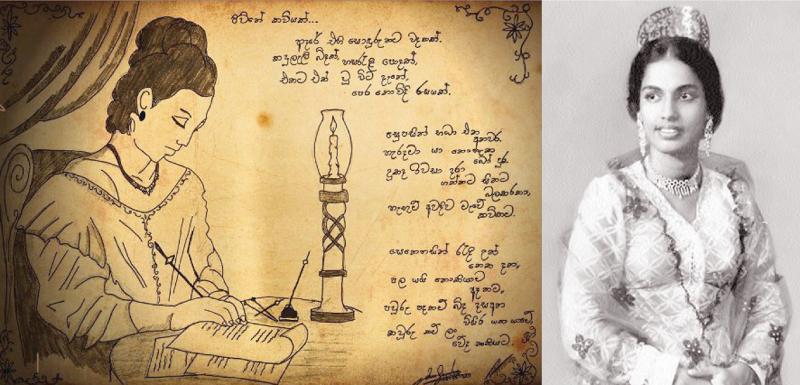
Gajaman Nona was a poetess of great repute during the Matara era or Matara Yugaya of Sri Lankan poetry. She was born in 1746 and was baptised as Dona Isabella Cornelia at St. Paul’s Church, Milagiriya, Bambalapitiya. It is said that as a baby she was brought to live in Kahawatta, Beliatta because her father, Wiratamulla Gamage Don Francisco Senaratna Kumara Perumal was a government servant working (doing rajakarirya) mainly in the Matara district. She subsequently lived in Thuppihigewatte, Weragampita, Matara, where her father served as the Arachchi in charge of the Thombu or records of births, marriages, deaths and land owners.
According to some records of this era, young Cornelia is supposed to have studied at the Milagiriya church school in Bambalapitiya. It is said that her mother, Fransinha Jasenthu Graivo was also a teacher at the school. Fransinha was sometimes known as Dona Nona Babi Hamine. Gajaman Nona.
Even as a young child, Dona Isabella Cornelia or Gajaman Nona had proved that she had an inborn talent for poetry, especially for impromptu poetry. This form of poetry is called Hituwana Kavi in Sinhala. Her uncle, Aththame Lekam, also a talented poet, realised the eight year old girl’s talent for poetry.
 The young poetess studied Sinhala, Pali, and Sanskrit and ancient poetry. Her poems were written in Sinhala, Pali and Sanskrit.
The young poetess studied Sinhala, Pali, and Sanskrit and ancient poetry. Her poems were written in Sinhala, Pali and Sanskrit.
Dona Isabella Cornelia grew up in a village environment and adapted herself to village life. According to historical chronicles she was one of the most beautiful girls in the village and many youth in the area was attracted to her. Living in a rustic environment surrounded by paddy fields, trees and birds of all species enhanced her poetic ability.
Though she was a Christian, Cornelia visited the neighbouring temple and the Viharadhipathi, Koratota Dhammarama thera was a poet of much reputation during that era. This was a time when women were not allowed to study in temples .Cornelia in the guise of a young boy frequented the temple simply because she wanted to develop her poetic aspirations and talents.
Dona Isabella Cornelia’s father became known as Gajaman Arachchi and thus Cornelia was later known as Gajaman Nona , the prefix Gajaman being taken from her father’s name. By this time she was a very popular poetess. There were well known people who loved her. One such person was the Elapatha Mudali who was a reputed citizen of the country during that era and much has been said about the alleged relationship between the two.
Gajaman Nona dressed elegantly. Her western style dress had puffed sleeves, a pleated blouse and a long, frilled and pleated skirt.
When she was 22 years old, she married Thalpita Arachchige Gardias also known as Thalpe Paththu Arachchi of Thalpe, Galle.and had one son. The baby was named Juwanis Alwis. Gardias too had a talent for poetry and their domestic conversations had often taken the form of impromptu poems. Gardias died after eight years of marriage leaving his wife and son destitute. Gajaman Nona’s father helped her. Many men proposed marriage to the still attractive GajamanNona but she refused them all.
Gajaman Nona’s father persuaded her to get married for a second time. Her second husband was a resident of Uyanwatta in Matara, Don Gabriel Hendick Siriwardena Wijewimalarathne Muhandiram. They had several sons but tragedy struck again as Gabriel too died at a young age leaving his family in straitened financial circumstances., Gajaman Nona had to resort to writing poems praising the rich to earn a living. She also taught students to write poetry to earn money. However, these earnings were insufficient to keep the home fires burning and her father had to extend financial support to her.
This talented poetess has gone down in Sri Lankan history as being the first Sri Lankan poetess to earn a living from her talent and craft.
Later, her father, Wiratamulla Gamage Don Francisco Senaratna Kumara Perumal Gajaman Arachchi was attacked and killed by a tusker when Gajaman Nona and her family and some others went on a pilgrimage to the holy mountain, Siripada or Adams Peak.
The renowned poetess wrote an appeal in poetry to the then British Government Agent in Matara. Sir John D’Oyly. He knew Sinhalese and furthermore, was well acquainted with Gajaman Nona. Her plight touched D’oyley very much and he gifted her a land (nindagama)..
Among Gajaman Nona’s well known works are the Denipitiye NugaRuka Wenuma (In praise of the giant banyan tree in Denipitiye), the petition to John D’Oyly, a message sent to Thilakaratne Mudali seeking his help, poems praising Lady Thilakaratne Dissanayke’s services to Buddhism, and elegies written for her father and Samarasekera Gunawardene Gajanayake.
Gajaman Nona has created an unforgettable niche in the annals of Sri Lankan poetry with her own inimitable brand of poetry. Some of it is powerful and some of it is harsh and sarcastic. She also displays a strong sense of humour.
Historical data shows that this great poetess lived a solitary and difficult life during the last years of her life. The death of her son, Don Davit who had become a bhikku was another great blow to her.
Gajaman Nona died on December 15, 1814 at the age of 56. (Some historical records give the year as 1815).
The famous Gajaman Nona statue is located at Nonagama junction ,Ambalantota, on the Matara- Hambantota (A2) main road
